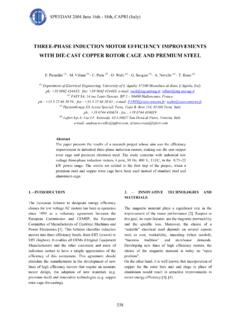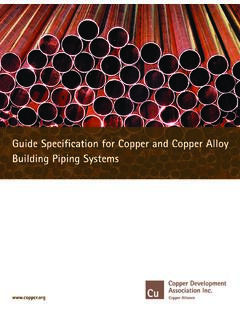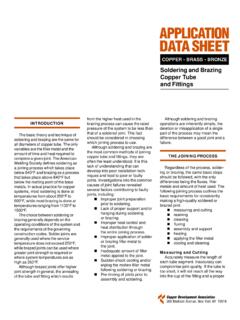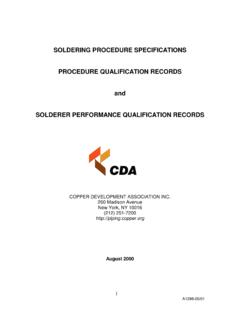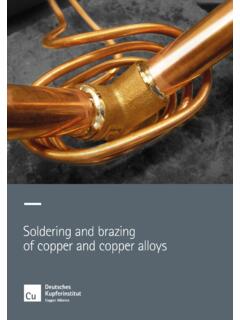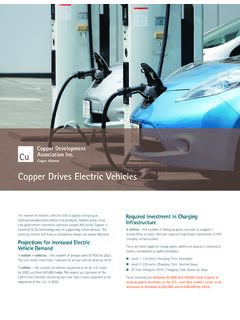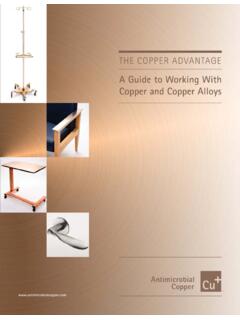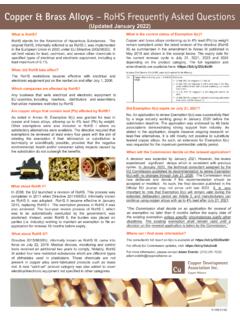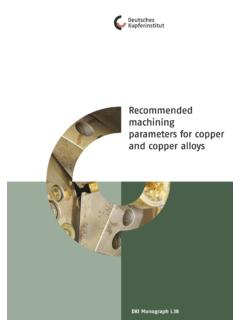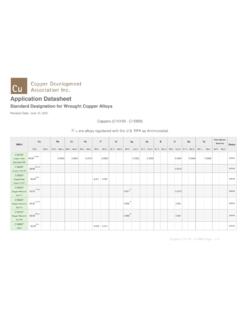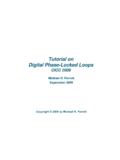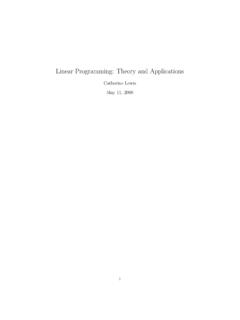Transcription of Guide to Nickel Aluminium Bronze for Engineers - Copper
1 Guide to Nickel Aluminium Bronze for Engineers Guide to Nickel Aluminium Bronze for Engineers Ivan Richardson, edited by Carol Powell Copper Development Association Publication No 222. January 2016. Acknowledgements: Copper Development Association would like to acknowledge the assistance of John Bailey, Roger Francis, John Galsworthy, Dominic Meigh, Carol Powell, Ladji Tikana, Clive Tuck and Peter Webster in the production of this publication. Copper Development Association is a non-trading organisation that promotes and supports the use of Copper based on its superior technical performance and its contribution to a higher quality of life. Its services, which include the provision of technical advice and information, are available to those interested in the utilisation of Copper and Copper alloys in all their aspects. The Association also provides a link between research and the user industries and is part of an international network of trade associations, the Copper Alliance.
2 Disclaimer Whilst this document has been prepared with care, we can give no warranty regarding the contents and shall not be liable for any direct, incidental or consequential damage arising out of its use. For complete information on any material, the appropriate standard should be consulted. Copyright 2016. Copper Development Association Cover page images: Adjustable bolted propeller one of two 33 tonne propellers from the Queen Elizabeth class aircraft carrier capable of producing 40 MW of thrust (Courtesy Rolls Royce Marine). Nickel Aluminium Bronze window frames, cladding and roof, Portcullis House, London Seawater pipe sections (Courtesy Inoxyda SA, France). 2 | Guide TO Nickel Aluminium Bronze FOR Engineers . Contents Comparative Corrosion Resistance of Various Copper -based Alloys in Seawater Erosion Stress Corrosion Typical Mechanical and Physical Corrosion Seawater Corrosion Comparison in Seawater with Other Alloy Development Corrosion Resistance of Nickel Aluminium Bronze in Chemical Sulphuric Acetic Hydrochloric Phosphoric Hydrofluoric Nitric Offshore Oil/Gas and Bearing Applications within Oil Rig Other Corrosive Chemical Communications and Actuator Weld Oil Galvanic Desalination and Water Condenser Selective Phase Stress Porosity and Gas Alloying Elements and Microstructural Heat 47.
3 Influence of Alloying Stress Quenching and Heat Treatment of Cast Heat Treatments in International Types of Microstructural Wear and Galling 52. 26 Fretting Mechanical Low and High Temperature Impact Fabrication and 56. Fatigue Creep Magnetic Welding Joining Recommended Welding Corrosion 32 TIG/GTAW MIG/GMAW Protective Surface Manual Metal Oxidation at Elevated Electron Beam Friction Crevice Laser Selective Phase Welding Practice and Joint Galvanic Design of Weld Electrical Leakage (Stray Current) Sulphide Guide TO Nickel Aluminium Bronze FOR Engineers | 3. Contents Appendix Pre-heating and Weld Run Appendix: Tables 82. Temperature Selection of Filler Materials for Standards, Designations, Chemical Compositions and Mechanical TIG/GTAW and MIG/GMAW Properties Post Weld Heat Stress International Standards Full Table App1 Nickel Aluminium Bronze - Table App2 Nickel Aluminium Bronze Rough and Finishing UK: Nickel Aluminium Bronze - Wrought Slot Table App3 Chemical 70.
4 Table App4 Mechanical Mechanical and Non-destructive 71. Mechanical 71. UK: Nickel Aluminium Bronze Cast Non-destructive 71. Table App5 Chemical Manufacture - Casting Table App6 Mechanical Modern Casting Continuous Casting UK/European: Nickel Aluminium Bronze Wrought Computer Table App7 Chemical Continuous Table App8 Mechanical Centrifugal Wrought Hot Working Hot Working UK/European: Nickel Aluminium Bronze Cast Cold Table App9 Chemical Table App10 Mechanical France: Nickel Aluminium Bronze Wrought Table App11 Chemical Table App12 Mechanical Summary Guidelines for 79. France: Nickel Aluminium Bronze Cast References and Further 80 Table App13 Chemical Table App14 Mechanical General Publications from Copper Development Germany: Nickel Aluminium Bronze Wrought Association (CDA) .. 81 Table App15 Chemical Other Table App16 Mechanical Germany: Nickel Aluminium Bronze Cast Table App17 Chemical Table App18 Mechanical USA: Nickel Aluminium Bronze Wrought Table App19 Chemical Table App20 Mechanical USA: Nickel Aluminium Bronze Cast Table App21 Chemical Table App22 Mechanical 4 | Guide TO Nickel Aluminium Bronze FOR Engineers .
5 Introduction Alloys of Copper and Aluminium are known as Aluminium Bronze and, together with other alloying additions, produce a range of properties that are beneficial to a diverse range of industries. Of these, the Nickel Aluminium Bronze group of alloys is the most widely used. They have been adapted with time to optimise performance and can provide a combination of properties that can offer an economic alternative to other types of alloy systems. Nickel Aluminium bronzes are available in both cast and wrought product forms and have a unique combination of properties: Excellent wear and galling resistance High strength Density (10% lighter than steel). Non-sparking Low magnetic permeability (of < in selected grades). High corrosion resistance Good stress corrosion properties Good cryogenic properties High resistance to cavitation Damping capacity twice that of steel High resistance to biofouling A protective oxide surface film which has the ability to self-repair.
6 End uses range from landing gear bushing and bearings for all of the world's commercial aircraft to seawater pumps and valves, propellers for naval and commercial shipping, non-sparking tools in the oil and gas industry and pleasing facades in architecture. The Nickel Aluminium Bronze alloys are fairly complex materials and, during manufacture, require good control of the metal structure by attention to composition and heat treatment. As such it is the purpose of this publication to provide an engineering overview of the properties of the alloys, their specifications and their applications for operators, designers, manufacturers and fabricators. Their corrosion behaviour is explained and guidance is given to obtain optimum service performance. Methods of manufacture, welding and fabrication are also described and a list of references and useful publications is provided. The Appendix covers full details of designations, specifications and related composition and mechanical property requirements.
7 Guide TO Nickel Aluminium Bronze FOR Engineers | 5. Overview Broadly, the Nickel Aluminium bronzes can be classified as alloys containing 6-13% Aluminium and up to 7% iron and 7% Nickel . The more common alloys normally contain 3-6% each of these two elements. Manganese up to approximately is also added, both as a deoxidant and a strengthening element. There is a separate family of alloys which contain up to 14% manganese with additions of iron and Nickel . They are called here manganese Aluminium bronzes and the standard alloy, designated CuMn11Al8Fe3Ni3, is discussed briefly in later sections. Table 1 below gives an indication of a range of Aluminium Bronze alloy properties with increasing alloy additions and strength. Alloys CW304G, CW307G and CW308G are Nickel Aluminium bronzes. Table 1 - Specification BS EN 12165 Wrought Forgings 6-80 mm Diameter Alloy Cu Al Fe Ni Mn Si Proof Tensile Elongation Hardness % % % % % % Strength Strength % HB.
8 N/mm (MPa) N/mm (MPa). CW305G Rem 180 420 20 100. CW303G Rem max 180 460 30 110. CW304G Rem 180 500 30 115. CW302G Rem 250 500 20 120. CW306G Rem 250 500 20 120. CW307G Rem max 350 650 12 180. CW308G Rem max 450 750 5 190. Since the first manufacture of Aluminium Bronze in the 1850s, there has been a progressive development in elemental additions to improve the mechanical properties and corrosion resistance. The early alloys were binary systems of Copper and Aluminium with Aluminium in the range 6-11%. Up to about 8-9% Aluminium , the equilibrium metal structure is single phase and progressively increases in strength as the Aluminium increases. Such alloys were found to be ductile and suitable for cold worked products. At higher Aluminium levels, a second phase occurs in the structure at higher temperatures which, when retained by cooling quickly, is stronger and harder with good corrosion resistance and better erosion resistance.
9 Alloys typically containing 9-10% Aluminium became noted for their strength but, as their ductility for forming was better at high temperatures, the two phase alloys were more conveniently hot worked. If slow cooled below 565oC, however, the structure alters again, becoming less ductile and also more susceptible to corrosion in seawater. By 1914 the temper hardening features of Aluminium Bronze containing Nickel were recognised (1). Its presence, together with iron additions to suppress unwanted structural phases , became fully appreciated over the next decade (2) and now forms the basis of the modern complex alloy systems. The combined additions of iron and Nickel are particularly important as they also improve the strength and corrosion resistance. When both are present at nominally 5%, they modify the structure of 9-10% Aluminium alloys beneficially and the properties can be further enhanced by quench and temper heat treatments.
10 These are the most popular type of Nickel Aluminium bronzes for seawater service and a range of wrought and cast product forms is available. Aluminium has a strong affinity for oxygen. This is important for the corrosion resistance of the alloys as it plays an important part of the surface protective film, but Aluminium oxides can also be present as internal inclusions in the metal and historically these inclusions, together with shrinkage cavities formed when the alloys were cast, prevented their initial commercial development. However, in 1913 Pierre Gaston Durville developed a casting method called the Durville process', which became synonymous with the early production of the alloys. This was a non- turbulent mould tilting process which enabled billet and castings to be produced without the detrimental oxide inclusions. In more recent years, the original Durville process' has been superseded by more economic casting processes such as semi and continuous casting methods, where cooling rates and control of oxide inclusions are more sophisticated.
